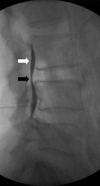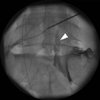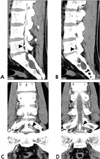Abstract
The utilization of transforaminal epidural steroid injections (TFESIs), an elective diagnostic and therapeutic spinal procedure, has risen dramatically over the past decade. The transforaminal technique uses a needle that approaches the posterolateral aspect of the intervertebral foramen. Despite the superiority of the transforaminal route, transforaminal blocks have been associated with devastating neurological complications, particularly paraplegia. Since the radiological target advocated for transforaminal injections matches the superoanterior portion of the foramen, it comes as no surprise that this approach renders radiculomedullary arteries vulnerable to injury. The author uses retrograde interlaminar ventral epidural steroid injection with catheters to obtain a theoretically advantageous placement of epidural corticosteroid. Epidurography of such injections does demonstrate that this approach more frequently achieves coverage of both the putative disc source of nerve irritation and of the affected segmental nerve.
Figures and Tables
 | Fig. 1Fluoroscopic lateral image of a ventral epidural space with contrast media spreading. Ventral epidural space is narrow at the disc level (black arrow) compared with supraoraminal level (white arrow). |
 | Fig. 2Fluoroscopic image (antero-posterior view) of epidural steroid injection of the right S1 root. Arrow, intraforaminal and epidural portion of the exiting nerve root. |
 | Fig. 3Radiographs of 57-year-old woman with radiating pain to left buttock and lower leg in L4 dermatome. MR image (not shown) revealed left paracentral L3/4 disc herniation with compression of left L4 nerve root. Pars interarticularis TFESI was performed at L4 neural foramen. (A) Antero-posterior view with contrast media spreading to L3/4 disc through the epidural space. (B) Lateral view showing needle tip in posterior aspect of the L4/5 neural foramen. |
 | Fig. 4CT images showing the path of catheter at sagittal view (A, B) and coronal view (C, D). Black arrow heads indicate the localization of catheter tip. |
 | Fig. 5CT axial view at S1 level showing the path of catheter. The catheter was advanced through the space between dural sac and left S1. The catheter tip (black arrow head) is located at the ventrocaudal aspect of left S1 nerve root. |
 | Fig. 6Fluoroscopic antero-posterior (A) and lateral (B) image of left L5, S1 RLIVESI. The catheter was placed in the ventrocaudal aspect of exiting nerve root in antero-posterior view (white arrow head). Note that the contrast media spreads through the ventral epidural space at the L5 level (black arrow head) in lateral view. Contrast media filling defect was observed at the L5S1 disc level due to left posterolateral disc extrusion (white arrow head). |
References
1. Botwin KP, Natalicchio J, Hanna A. Fluoroscopic guided lumbar interlaminar epidural injections: a prospective evaluation of epidurography contrast patterns and anatomical review of the epidural space. Pain Physician. 2004. 7:77–80.
2. Ackerman WE 3rd, Ahmad M. The efficacy of lumbar epidural steroid injections in patients with lumbar disc herniations. Anesth Analg. 2007. 104:1217–1222.

3. Schaufele MK, Hatch L, Jones W. Interlaminar versus transforaminal epidural injections for the treatment of symptomatic lumbar intervertebral disc herniations. Pain Physician. 2006. 9:361–366.
4. Karppinen J, Malmivaara A, Kurunlahti M, Kyllonen E, Pienimaki T, Nieminen P, Ohinmaa A, Tervonen O, Vanharanta H. Periradicular infiltration for sciatica: a randomized controlled trial. Spine (Phila Pa 1976). 2001. 26:1059–1067.
5. Kraemer J, Ludwig J, Bickert U, Owczarek V, Traupe M. Lumbar epidural perineural injection: a new technique. Eur Spine J. 1997. 6:357–361.

6. Vad VB, Bhat AL, Lutz GE, Cammisa F. Transforaminal epidural steroid injections in lumbosacral radiculopathy: a prospective randomized study. Spine (Phila Pa 1976). 2002. 27:11–16.
7. Viton JM, Rubino T, Peretti-Viton P, Bouvenot G, Delarque A. Short-term evaluation of periradicular corticosteroid injections in the treatment of lumbar radiculopathy associated with disc disease. Rev Rhum Engl Ed. 1998. 65:195–200.
8. Weiner BK, Fraser RD. Foraminal injection for lateral lumbar disc herniation. J Bone Joint Surg Br. 1997. 79:804–807.

9. Brouwers PJ, Kottink EJ, Simon MA, Prevo RL. A cervical anterior spinal artery syndrome after diagnostic blockade of the right C6-nerve root. Pain. 2001. 91:397–399.

10. Hodges SD, Castleberg RL, Miller T, Ward R, Thornburg C. Cervical epidural steroid injection with intrinsic spinal cord damage. Two case reports. Spine (Phila Pa 1976). 1998. 23:2137–2142. discussion 41-2.
11. Ludwig MA, Burns SP. Spinal cord infarction following cervical transforaminal epidural injection: a case report. Spine (Phila Pa 1976). 2005. 30:E266–E268.
12. Muro K, O'Shaughnessy B, Ganju A. Infarction of the cervical spinal cord following multilevel transforaminal epidural steroid injection: case report and review of the literature. J Spinal Cord Med. 2007. 30:385–388.

13. Rozin L, Rozin R, Koehler SA, Shakir A, Ladham S, Barmada M, Dominick J, Wecht CH. Death during transforaminal epidural steroid nerve root block (C7) due to perforation of the left vertebral artery. Am J Forensic Med Pathol. 2003. 24:351–355.

14. Tiso RL, Cutler T, Catania JA, Whalen K. Adverse central nervous system sequelae after selective transforaminal block: the role of corticosteroids. Spine J. 2004. 4:468–474.

15. Suresh S, Berman J, Connell DA. Cerebellar and brainstem infarction as a complication of CT-guided transforaminal cervical nerve root block. Skeletal Radiol. 2007. 36:449–452.

16. Beckman WA, Mendez RJ, Paine GF, Mazzilli MA. Cerebellar Herniation After Cervical Transforaminal Epidural Injection. Reg Anesth Pain Med. 2006. 31:282–285.

17. Bose B. Quadriparesis following cervical epidural steroid injections: case report and review of the literature. Spine J. 2005. 5:558–563.

18. Glaser SE, Falco F. Paraplegia following a thoracolumbar transforaminal epidural steroid injection. Pain Physician. 2005. 8:309–314.
19. Houten JK, Errico TJ. Paraplegia after lumbosacral nerve root block: report of three cases. Spine J. 2002. 2:70–75.
20. Kennedy DJ, Dreyfuss P, Aprill CN, Bogduk N. Paraplegia following image-guided transforaminal lumbar spine epidural steroid injection: two case reports. Pain Med. 2009. 10:1389–1394.

21. Quintero N, Laffont I, Bouhmidi L, Rech C, Schneider AE, Gavardin T, Dizien O. Transforaminal epidural steroid injection and paraplegia: case report and bibliographic review. Ann Readapt Med Phys. 2006. 49:242–247.
22. Wybier M, Gaudart S, Petrover D, Houdart E, Laredo JD. Paraplegia complicating selective steroid injections of the lumbar spine. Report of five cases and review of the literature. Eur Radiol. 2010. 20:181–189.

23. Baker R, Dreyfuss P, Mercer S, Bogduk N. Cervical transforaminal injection of corticosteroids into a radicular artery: a possible mechanism for spinal cord injury. Pain. 2003. 103:211–215.

24. Huntoon MA, Martin DP. Paralysis after transforaminal epidural injection and previous spinal surgery. Reg Anesth Pain Med. 2004. 29:494–495.

25. Rathmell JP, Aprill C, Bogduk N. Cervical transforaminal injection of steroids. Anesthesiology. 2004. 100:1595–1600.

26. Scanlon GC, Moeller-Bertram T, Romanowsky SM, Wallace MS. Cervical transforaminal epidural steroid injections: more dangerous than we think? Spine. 2007. 32:1249–1256.

27. Okubadejo GO, Talcott MR, Schmidt RE, Sharma A, Patel AA, Mackey RB, Guarino AH, Moran CJ, Riew KD. Perils of intravascular methylprednisolone injection into the vertebral artery. An animal study. J Bone Joint Surg Am. 2008. 90:1932–1938.

28. Dawley JD, Moeller-Bertram T, Wallace MS, Patel PM. Intra-arterial injection in the rat brain: evaluation of steroids used for transforaminal epidurals. Spine. 2009. 34:1638–1643.
29. Glaser SE, Shah RV. Root cause analysis of paraplegia following transforaminal epidural steroid injections: The 'unsafe' triangle. Pain Physician. 2010. 13:237–244.
30. Benzon HT, Chew TL, McCarthy RJ, Benzon HA, Walega DR. Comparison of the particle sizes of different steroids and the effect of dilution: a review of the relative neurotoxicities of the steroids. Anesthesiology. 2007. 106:331–338.

31. Malhotra G, Abbasi A, Rhee M. Complications of transforaminal cervical epidural steroid injections. Spine. 2009. 34:731–739.

32. Smuck M, Fuller BJ, Chiodo A, Benny B, Singaracharlu B, Tong H, Ho S. Accuracy of intermittent fluoroscopy to detect intravascular injection during transforaminal epidural injections. Spine. 2008. 33:E205–E210.

33. Buenaventura RM, Datta S, Abdi S, Smith HS. Systematic review of therapeutic lumbar transforaminal epidural steroid injections. Pain Physician. 2009. 12:233–251.
34. Bogduk N. Lumbar spinal nerve block. Practice guidelines for spinal diagnostic and treatment procedures. 2004. San Francisco: International Spinal Injection Society;3–19.
35. Alleyne CH Jr, Cawley CM, Shengelaia GG, Barrow DL. Microsurgical anatomy of the artery of Adamkiewicz and its segmental artery. J Neurosurg. 1998. 89:791–795.

36. Biglioli P, Spirito R, Roberto M, Grillo F, Cannata A, Parolari A, Maggioni M, Coggi G. The anterior spinal artery: the main arterial supply of the human spinal cord--a preliminary anatomic study. J Thorac Cardiovasc Surg. 2000. 119:376–379.

37. Lo D, Vallee JN, Spelle L, Cormier E, Saillant G, Rancurel G, Chiras J. Unusual origin of the artery of Adamkiewicz from the fourth lumbar artery. Neuroradiology. 2002. 44:153–157.

38. Huntoon MA. Anatomy of the cervical intervertebral foramina: vulnerable arteries and ischemic neurologic injuries after transforaminal epidural injections. Pain. 2005. 117:104–111.

39. Balblanc JC, Pretot C, Ziegler F. Vascular complication involving the conus medullaris or cauda equina after vertebral manipulation for an L4-L5 disk herniation. Rev Rhum Engl Ed. 1998. 65:279–282.
40. Lew HL, Coelho P, Chou LH. Preganglionic approach to transforaminal epidural steroid injections. Am J Phys Med Rehabil. 2004. 83:378.

42. Levi D. Intradiscal flow during a transforaminal epidural steroid injection. Pain Med. 2010. 11:716–718.

43. Moon HS, Shin BC, Im HS, Song BH, Cha YD. Inadvertent discogram during transforaminal epidural injection in patients with lumbar disc herniation - a report of 2 cases. Korean J Anesthesiol. 2010. 58:104–108.

44. Plastaras CT, Casey E, Goodman BS, Chou L, Roth D, Rittenberg J. Inadvertent intradiscal contrast flow during lumbar transforaminal epidural steroid injections: a case series examining the prevalence of intradiscal injection as well as potential associated factors and adverse events. Pain Med. 2010. 11:1765–1773.

45. Vallejo R, Benyamin R, Yousuf N, Kramer J. Intradiscal intravasation of contrast during a transforaminal epidural injection. Pain Pract. 2007. 7:285–287.

46. Kambin P. Arthroscopic microdiskectomy. Mt Sinai J Med. 1991. 58:159–164.
47. Kambin P, Savitz MH. Arthroscopic microdiscectomy: an alternative to open disc surgery. Mt Sinai J Med. 2000. 67:283–287.
48. Ruan X, Chiravuri S. Truly a critical review: root cause analysis of paraplegia following transforaminal epidural steroid injections:"unsafe" triangle. Pain Physician. 2011. 14:E82–E83.
49. Candido KD, Raghavendra MS, Chinthagada M, Badiee S, Trepashko DW. A prospective evaluation of iodinated contrast flow patterns with fluoroscopically guided lumbar epidural steroid injections: the lateral parasagittal interlaminar epidural approach versus the transforaminal epidural approach. Anesth Analg. 2008. 106:638–644.

50. Jeong HS, Lee JW, Kim SH, Myung JS, Kim JH, Kang HS. Effectiveness of transforaminal epidural steroid injection by using a preganglionic approach: a prospective randomized controlled study. Radiology. 2007. 245:584–590.

51. Wolff AP, Groen GJ, Wilder-Smith OH. Influence of needle position on lumbar segmental nerve root block selectivity. Reg Anesth Pain Med. 2006. 31:523–530.

52. Botwin K, Natalicchio J, Brown LA. Epidurography contrast patterns with fluoroscopic guided lumbar transforaminal epidural injections:a prospective evaluation. Pain Physician. 2004. 7:211–215.
53. Manchikanti L, Cash KA, Pampati V, Damron KS, McManus CD. Evaluation of lumbar transforaminal epidural injections with needle placement and contrast flow patterns: a prospective, descriptive report. Pain Physician. 2004. 7:217–223.
54. Friedman R, Li V, Mehrotra D, Mosuro Y, Atkinson G. Foraminal injection of a painful sacral nerve root using an epidural catheter: case report. Reg Anesth Pain Med. 2002. 27:214–216.

55. Choi YK, Barbella JD. Evaluation of epidurographic contrast patterns with fluoroscopic-guided lumbar interlaminar ventral epidural injection. Pain Pract. 2009. 9:275–281.

56. Shim JC, Koh SY, Shim JH, Jeong MA, Kim DW. Society TKP. Lumbar interlaminar ventra epidural injection: anterograde vs retrograde approach. The 50th scientific meeting of the Korean Pain Society. 2010. Seoul: The Korean Pain Society;81.
57. Murthy NS, Maus TP, Behrns CL. Intraforaminal location of the great anterior radiculomedullary artery (artery of Adamkiewicz): a retrospective review. Pain Med. 2010. 11:1756–1764.




 PDF
PDF ePub
ePub Citation
Citation Print
Print


 XML Download
XML Download